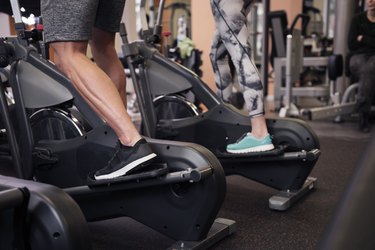
Why use an elliptical with a stride that's too long or too short when you can find the proper fit? You'll want to find an elliptical stride length that's comfortable for you and will allow you to get the most out of your workout.
Elliptical Training Tips
Video of the Day
Before determining elliptical stride length, consider a few tips:
Video of the Day
- Watch your posture: When using an elliptical make sure to maintain good posture. Shoulders should be back, abdominals tight, head high.
- Let your lower body support your weight and don't lean on the handles, says Mayo Clinic.
- Maintain your stride: Make sure you stay relaxed and your stride is consistent as you go through your standard range of motion.
- Consistency is key: Make using the elliptical a habit. Try to set specific times and days to get in your elliptical workout and stick to it.
- Keep in mind that incline adjustments shift emphasis to certain muscle groups, and, according to ExRx.net, lower resistance means higher speed, which increases workout intensity.
If you're purchasing an elliptical of your own, a few other factors to take into consideration, according to Consumer Reports, are safety features, resistance range and exercise programs such as random, hill climb and interval.
Read more: The 20 Best Fitness Tips of All Time
Determining Elliptical Stride Length
Make sure to exercise on an elliptical appropriate for your leg movement range or you may risk injury to your hips and knees. Better yet, use a machine that allows you to adjust the elliptical stride length to fit your needs.
A good elliptical stride length fit should allow you to maintain the proper posture and reap the most benefits out of your workout. Failure to remain in an upright position on the elliptical can lead to back injuries. The handrails should also help you keep proper posture, as they provide support so you don't have to lean forward.
Read more: The Average Stride Length in Running
Stride Length Based on Height
Elliptical stride length should be determined by the user's height. Some telltale signs that the elliptical is not the right fit, according to Octane Fitness, a manufacturer of elliptical machines, include feeling that the exercise is choppy or uncomfortable or that you're overstretching. Approximate height guidelines for forward stride are:
- 5 feet to 5 feet, 1 inch: Walking stride 18.5 inches, jogging stride 19.5 inches and running stride 21 inches.
- 5 feet, 1 inch to 5 feet, 3 inches: Walking stride 19.5 inches, jogging stride 20.5 inches and running stride 22 inches.
- 5 feet, 3 inches to 5 feet, 5 inches: Walking stride 20 inches, jogging stride 21 inches and running stride 22.5 inches.
- 5 feet, 5 inches to 5 feet, 8 inches: Walking stride 20.5 inches, jogging stride 21.5 inches and running stride 23 inches.
- 5 feet, 8 inches to 5 feet, 10 inches: Walking stride 21 inches, jogging 22 inches and running stride 23.5.
- 5 feet, 10 inches to 6 feet: Walking stride 21.5 inches, jogging stride 22.5 inches and running stride 24 inches.
Most elliptical machines are fixed stride, although there are also several adjustable-stride models you can purchase or use at the gym. Adjustable-stride options are great for families or workout spaces where there people of varying heights are using the machine.
Stride Length Affects Lumbar Motion
One small study (with a sample of 40 healthy males) published in the August 2012 issue of Clinical Biomechanics, found that stride length affects lumbar, or lower back, motion. The study sought to compare walking movements to elliptical movements and observe how stride lengths, hand positions and speed influenced the workout.
Some of the findings showed that gluteal muscle activation was greater with elliptical training than with walking and that lumbar rotation and bending angles were greater on the elliptical trainer. Walking, on the other hand, produced a greater frontal motion.
- Consumer Reports: "Elliptical Buying Guide"
- Clinical Biomechanics: "How Do Elliptical Machines Differ From Walking: A Study of Torso Motion and Muscle Activity"
- Octane Fitness: "Operations Manual"
- Mayo Clinic: "Are Elliptical Machines Better Than Treadmills for Basic Aerobic Workouts?"
- ExRx.net: "Elliptical Trainer"